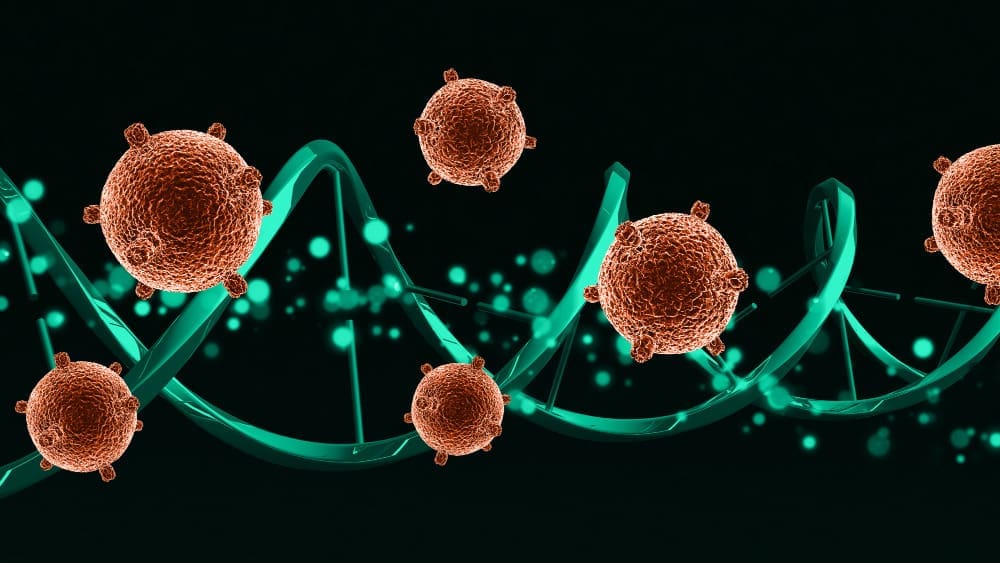Last Updated on November 27, 2025 by Bilal Hasdemir

Autoimmune diseases happen when the body’s immune system attacks its own tissues. Recent studies show that these diseases are often linked to inherited genetic variants. We look into the genetic roots of these conditions and how family patterns and hereditary risks affect them.
Conditions like lupus or type 1 diabetes occur when the immune system mistakenly attacks the body’s own tissues. Knowing the genetic factors and environmental triggers helps in managing and treating these conditions. At Liv Hospital, we focus on autoimmune care, using our knowledge of hereditary risks to support our patients fully.
Key Takeaways
- Autoimmune conditions are influenced by inherited genetic variants.
- Family patterns and hereditary risks play a significant role in the development of autoimmune conditions.
- Understanding genetic predisposition is key to managing autoimmune conditions.
- Environmental triggers can contribute to the onset of autoimmune conditions.
- Liv Hospital offers patient-centered expertise in autoimmune care.
The Nature of Autoimmune Diseases
Autoimmune diseases happen when the immune system gets confused. It starts to see the body’s own cells as enemies. This causes millions of people worldwide to suffer from these conditions.
What Happens in Autoimmune Conditions
The immune system mistakenly attacks the body’s own cells and tissues. This leads to inflammation and damage. The symptoms vary based on which parts of the body are affected.
Common Types of Autoimmune Disorders
There are over 80 known autoimmune diseases. They affect different parts of the body. Some common ones include:
- Type 1 diabetes, where the immune system attacks the insulin-producing beta cells in the pancreas.
- Rheumatoid arthritis, characterized by inflammation of the joints due to immune system dysregulation.
- Lupus, a condition that can affect multiple organs, including the skin, joints, and kidneys.
| Disease | Primary Affected Area | Key Symptoms |
|---|---|---|
| Type 1 Diabetes | Pancreas | High blood sugar, fatigue |
| Rheumatoid Arthritis | Joints | Pain, swelling, stiffness |
| Lupus | Multiple organs | Fatigue, skin rashes, joint pain |
We’ve looked into autoimmune diseases. They occur when the immune system can’t tell self from non-self. This causes a variety of conditions, like type 1 diabetes and lupus, each with its own symptoms and affected areas.
The Genetic Basis of Autoimmune Disease
Autoimmune diseases often run in families, showing a strong genetic link. This means people with a family history of these diseases are more likely to get them. We’ll look at the evidence for genetics playing a role and the complex ways they are passed down.
Evidence for Genetic Influence
Many studies show genetics are key in autoimmune diseases. For example, certain genetic variants raise the risk of diseases like type 1 diabetes and rheumatoid arthritis. But having a variant doesn’t mean you’ll definitely get the disease.
Some key evidence includes:
- Autoimmune diseases are more common in monozygotic twins than dizygotic twins.
- Genome-wide association studies have found specific genetic loci linked to these diseases.
- Autoimmune diseases are more common in families with a history of them.
Complex Inheritance Patterns
Autoimmune diseases have complex inheritance patterns. They are influenced by many genes and environmental factors. Unlike simple genetic disorders, these diseases are polygenic, with each gene having a small effect.
Environmental triggers can also play a role. For example, certain exposures can trigger an autoimmune disease in people who are genetically predisposed. Understanding these interactions is key to finding effective treatments.
As we learn more about the genetics of autoimmune diseases, it’s clear they’re not just about genes. It’s the mix of genetics and environment that matters. This knowledge opens up new research paths for preventing and treating these diseases.
Family Patterns and Hereditary Risk
Autoimmune conditions often run in families. This shows that genes might play a big role in their development. When many family members have these diseases, it points to a genetic link.
Clustering of Autoimmune Conditions in Families
Studies show that people with a family history of autoimmune diseases are at higher risk. For example, having a family history of type 1 diabetes increases your risk. This pattern is seen across different autoimmune diseases in the same family.
Having one autoimmune disease in a family member can raise the risk for others. This could mean they might get the same disease or even different ones. It seems like there’s a shared genetic risk in families.
Calculating Relative Risk for Family Members
Researchers use relative risk to understand hereditary risk. It compares the chance of getting a disease with a family history to those without. This helps see how much of a risk family history poses.
The table below shows the relative risk for certain autoimmune diseases based on family history:
| Autoimmune Disease | Relative Risk if First-Degree Relative is Affected |
|---|---|
| Type 1 Diabetes | 15-20 times higher |
| Rheumatoid Arthritis | 2-4 times higher |
| Lupus | 5-10 times higher |
Knowing these risks can lead to early detection and prevention. It’s key for families with a history of autoimmune diseases to stay vigilant. Awareness and monitoring are vital.
Twin Studies: The Genetic Connection
Scientists have learned a lot about autoimmune diseases by studying twins. Twin studies help us understand how genes and environment work together. This knowledge is key to figuring out why these diseases happen.
Concordance Rates in Identical vs. Fraternal Twins
One important finding from twin studies is the difference in concordance rates. Concordance rate is how likely both twins are to get the same disease if one does. Identical twins, who share the same DNA, have a much higher rate than fraternal twins.
For example, the concordance rate for identical twins is 25% to 50% for certain autoimmune diseases. This shows that genes play a big role in these diseases. But, the fact that it’s not 100% shows environment also matters.
What Twin Studies Reveal About Heritability
Twin studies tell us a lot about the heritability of autoimmune diseases. Heritability shows how much of a trait or condition comes from genetics. The higher rate in identical twins shows a big genetic link to these diseases.
But, twin studies also show that genes aren’t everything. Environmental factors and other non-genetic things also play a big part. This knowledge helps us better prevent, diagnose, and treat these diseases.
We now know that autoimmune diseases come from a mix of genes and environment. Understanding this mix is key to managing and maybe even preventing these conditions.
Understanding Autoimmune Disease Inheritance
Autoimmune diseases come from a mix of genetic factors. We’re not born with them, but we might have a genetic risk. This risk can turn into a disease when we’re exposed to certain triggers.
Is Autoimmune Disease Hereditary?
Autoimmune diseases have a strong genetic link, but they’re not passed down in a simple way. Many genetic variants play a role. If your family has a history of these diseases, you’re more likely to get them.
For example, having a close relative with an autoimmune disease raises your risk. But having a genetic risk doesn’t mean you’ll definitely get the disease.
| Autoimmune Disease | Relative Risk | General Population Prevalence |
|---|---|---|
| Rheumatoid Arthritis | 2-4 times higher | 1% |
| Type 1 Diabetes | 6-12 times higher | 0.3% |
| Lupus | 5-10 times higher | 0.1% |
Patterns of Inheritance Across Generations
The way autoimmune diseases are passed down is complex. They involve many genes, not just one. This makes them different from single-gene disorders.
Genetic variations can combine in many ways. This leads to different expressions of the disease in family members. Environmental factors also trigger the disease in those at risk.
Knowing these patterns helps us understand the risk for family members. It can guide us to take preventive steps or start treatment early.
The HLA Region: A Major Genetic Player
The Human Leukocyte Antigen (HLA) region on chromosome 6 is key in autoimmune disease risk. It helps the immune system tell self from non-self. This is vital for fighting off viruses and bacteria.
Understanding Human Leukocyte Antigens
HLA proteins are on white blood cells and other body tissues. They help the immune system fight off pathogens. The HLA region has many variations, leading to diverse immune responses.
Some HLA genes raise the risk of certain autoimmune diseases. For example, HLA-B27 is linked to ankylosing spondylitis. HLA-DRB1 is tied to rheumatoid arthritis. Knowing these links can help prevent these diseases.
How HLA Genes Influence Autoimmune Risk
HLA genes affect how the immune system sees self and non-self. Some HLA alleles might trigger autoimmunity by showing self-antigens to T-cells.
- Antigen Presentation: HLA molecules show peptides to T-cells. If linked to disease, they might show self-peptides, causing autoimmunity.
- Immune Response Regulation: Certain HLA genes can affect the immune response. This might lead to autoimmunity.
- Genetic Predisposition: People with specific HLA alleles might be more likely to get certain autoimmune diseases. This is if they’re exposed to the right triggers.
Understanding HLA genes and autoimmune disease risk shows the complex relationship between genes and environment. This knowledge helps us grasp how these conditions develop.
Beyond HLA: Other Genetic Factors
Autoimmune diseases are not just about the HLA region. Many gene variants with small effects play a role. These genes, along with HLA, help us understand the risk of autoimmune diseases. Knowing this helps us create better treatment plans.
Multiple Gene Variants with Small Effects
Studies have found many genetic variants linked to autoimmune diseases. Each variant has a small effect, but together they significantly increase disease risk. For example, dozens of genes each have a small impact, making a big difference in disease risk.
These genes affect how our immune system works. They influence things like cytokine production and T-cell activation. By understanding these effects, we can better predict who might get an autoimmune disease.
Shared Genetic Risk Across Different Autoimmune Conditions
Many genetic risks are common to different autoimmune diseases. This is why people with one disease are more likely to get another. For example, genes linked to rheumatoid arthritis might also raise the risk of lupus or type 1 diabetes.
Knowing these shared risks helps us find treatments that work for many diseases. This could lead to better care for people with multiple conditions.
Exploring the genetic factors of autoimmune diseases is key to improving care. Our aim is to provide personalized care using the latest genetic research. This way, we can better meet the needs of each patient.
Are You Born With Autoimmune Diseases?
The question of whether we’re born with autoimmune diseases is complex. While genetics play a role, environmental factors also trigger these conditions.
Genetic Predisposition vs. Disease Development
We’re not born with most autoimmune diseases. Instead, we might have a genetic risk. Research shows some genes can make us more likely to get these diseases. But having these genes doesn’t mean we’ll definitely get sick.
Autoimmune diseases develop from a mix of genetics and environment. For example, studies on twins show that even with the same genes, they might not both get the same disease. This highlights the importance of environmental factors in starting these diseases.
“The presence of a genetic predisposition does not predetermine the development of an autoimmune disease; it sets the stage for environmental triggers to play a role.”
The Concept of Disease Threshold
The idea of a disease threshold is key to understanding how genetics and environment work together. A person might be genetically predisposed to disease, but it takes environmental triggers to push them over the threshold.
| Factors Influencing Autoimmune Disease Development | Description |
|---|---|
| Genetic Predisposition | Inherited genetic variants that increase susceptibility |
| Environmental Triggers | External factors such as infections, diet, or exposure to toxins |
| Disease Threshold | The point at which genetic predisposition and environmental triggers combine to cause disease onset |
It’s important to understand the difference between genetic risk and actual disease development. Knowing what causes autoimmune diseases helps us find ways to prevent and manage them.
Environmental Triggers and Genetic Susceptibility
Autoimmune diseases come from a mix of genes and the environment. Genes set the stage, but the environment can spark the disease. This mix is key to understanding these conditions.
The Gene-Environment Interaction
The link between genes and the environment is complex. Genetic predisposition makes some more likely to get autoimmune diseases. But, it’s usually environmental factors that start the disease.
Environmental factors include infections, diet, and chemicals. For example, some infections can start an autoimmune response in those at risk. Also, diet, like too much salt or not enough vitamin D, can raise the risk of autoimmune diseases.
Common Environmental Triggers
Many environmental factors can lead to autoimmune diseases. Some include:
- Infections: Viral and bacterial infections can start autoimmune responses.
- Dietary factors: Gluten, high salt, and missing nutrients can lead to disease.
- Chemical exposure: Some chemicals, like silica or solvents, are linked to autoimmune diseases.
Knowing these triggers helps us find ways to stop or slow autoimmune diseases. As we learn more about genes and environment, we get closer to tailored treatments.
Seeing the role of both genes and environment helps us understand autoimmune diseases better. This knowledge lets us help those at risk more effectively. It improves their lives.
Current Research and Future Directions
Research is now focused on the genetic roots of autoimmune diseases. This is opening up new paths for treatments. As we learn more about the genes involved, we’re finding new ways to diagnose and treat these conditions.
Genome-Wide Association Studies
Genome-wide association studies (GWAS) have changed how we study autoimmune diseases. They look at the genes of people with these conditions. This has helped find many genetic links to these diseases.
GWAS have shown that many genes play a role in autoimmune diseases. This means that different genes can make a person more likely to get these conditions.
GWAS have also found that some genes are common to many autoimmune diseases. For example, genes in the HLA region are linked to diseases like rheumatoid arthritis and type 1 diabetes. This shows that treatments for one disease might work for others too.
Personalized Medicine for Autoimmune Conditions
Genetic research, like GWAS, is helping us move towards personalized medicine. By knowing a person’s genes, doctors can give treatments that work better and have fewer side effects. This makes patients happier and helps avoid trying different treatments.
Personalized medicine uses genetic info to predict how likely someone is to get a disease. It also helps guess how well they’ll do and how they’ll react to treatments. As research gets better, we’ll see more treatments that really target the disease.
Managing Hereditary Risk of Autoimmune Disorders
Autoimmune diseases often run in families. This means we need to take steps to manage and prevent them. If you have a family history, knowing your risk is key.
Preventive Strategies for High-Risk Individuals
People at high risk can take steps to protect themselves. They should live a healthy lifestyle, avoid harmful environments, and keep up with vaccinations.
Key Preventive Measures:
- Eat a diet full of fruits, veggies, and omega-3s
- Stay active
- Don’t smoke or drink too much
- Use stress-reducing activities like meditation or yoga
By following these steps, you can lower your chance of getting autoimmune diseases.
Early Detection and Intervention
Finding diseases early is very important. Regular doctor visits can spot problems early.
| Benefit | Description |
|---|---|
| Timely Treatment | Starting treatment early can greatly improve results |
| Reduced Complications | Finding diseases early can stop serious problems later |
| Improved Quality of Life | Managing diseases well can make life better overall |
Understanding your risk and taking steps to prevent it can make a big difference. Working with your doctor, you can create a plan to lower your risk and get better results.
Conclusion: The Complex Interplay of Genes and Environment in Autoimmune Disease
Autoimmune diseases come from a mix of genes and environment. Understanding this mix is key to finding good treatments and ways to manage the disease.
Autoimmune diseases aren’t just about genes. They’re shaped by many genetic factors and environmental exposures. People with a family history of these diseases are more likely to get them. But, some people without a family history can also develop them, showing how complex it is.
By learning more about the genes and environment involved, we can help people with autoimmune diseases. Our aim is to give them the best care and support. We’re working hard to understand how these diseases are inherited and how to manage them well.
FAQ
Are autoimmune diseases genetic?
Autoimmune diseases have a genetic link, but they’re not just about genes. Studies show that inherited traits can raise the risk. Yet, environmental factors also play a big role.
Is an autoimmune disease hereditary?
Most autoimmune diseases aren’t passed down directly. Instead, people might inherit a risk factor. This, combined with environmental factors, can lead to disease.
What is the role of the HLA region in autoimmune disease susceptibility?
The HLA region is key to the immune system. Certain HLA genes can increase the risk of autoimmune diseases.
Are you born with autoimmune diseases?
There’s a genetic link, but you’re not born with the disease. Environmental triggers are needed for it to develop.
How do environmental triggers interact with genetic susceptibility?
Environmental factors can spark autoimmune responses in those with a genetic risk. Finding these triggers is key to preventing disease.
Can autoimmune diseases be prevented?
Knowing your risk and identifying triggers can help prevent or delay disease. It’s about creating a plan to stay healthy.
What is the significance of twin studies in understanding autoimmune diseases?
Twin studies show that identical twins are more likely to share autoimmune diseases. This highlights the genetic link.
How do multiple gene variants contribute to autoimmune disease risk?
Many gene variants have small effects on risk. Different diseases share genetic factors. This knowledge helps in finding better treatments.
What is the current state of research in autoimmune diseases?
New research, like genome-wide association studies, is uncovering causes. This opens doors to new treatments.
How can hereditary risk of autoimmune disorders be managed?
High-risk individuals can take preventive steps. Early detection and intervention help manage hereditary risk.
Are autoimmune diseases influenced by a single gene or multiple genes?
Autoimmune diseases are shaped by many genes. The inheritance patterns are complex, involving both genes and environment.
Can understanding genetic predisposition help in managing autoimmune diseases?
Knowing your genetic risk can lead to better prevention and treatment plans. It improves outcomes for those with autoimmune diseases.
Are autoimmune diseases genetic?
Autoimmune diseases have a genetic link, but they’re not just about genes. Studies show that inherited traits can raise the risk. Yet, environmental factors also play a big role.
Is an autoimmune disease hereditary?
Most autoimmune diseases aren’t passed down directly. Instead, people might inherit a risk factor. This, combined with environmental factors, can lead to disease.
What is the role of the HLA region in autoimmune disease susceptibility?
The HLA region is key to the immune system. Certain HLA genes can increase the risk of autoimmune diseases.
Are you born with autoimmune diseases?
There’s a genetic link, but you’re not born with the disease. Environmental triggers are needed for it to develop.
How do environmental triggers interact with genetic susceptibility?
Environmental factors can spark autoimmune responses in those with a genetic risk. Finding these triggers is key to preventing disease.
Can autoimmune diseases be prevented?
Knowing your risk and identifying triggers can help prevent or delay disease. It’s about creating a plan to stay healthy.
What is the significance of twin studies in understanding autoimmune diseases?
Twin studies show that identical twins are more likely to share autoimmune diseases. This highlights the genetic link.
How do multiple gene variants contribute to autoimmune disease risk?
Many gene variants have small effects on risk. Different diseases share genetic factors. This knowledge helps in finding better treatments.
What is the current state of research in autoimmune diseases?
New research, like genome-wide association studies, is uncovering causes. This opens doors to new treatments.
How can hereditary risk of autoimmune disorders be managed?
High-risk individuals can take preventive steps. Early detection and intervention help manage hereditary risk.
Are autoimmune diseases influenced by a single gene or multiple genes?
Autoimmune diseases are shaped by many genes. The inheritance patterns are complex, involving both genes and environment.
Can understanding genetic predisposition help in managing autoimmune diseases?
Knowing your genetic risk can lead to better prevention and treatment plans. It improves outcomes for those with autoimmune diseases.
References
GoodRx. Are Autoimmune Diseases Genetic? https://www.goodrx.com/health-topic/autoimmune/genetic-causes
Science. Potassium-Chloride Co-Transporter Gene, KCC2, Implicated In EIMFS, A Childhood Epileptic Syndrome. https://www.science.org/doi/10.1126/science.adg2992








